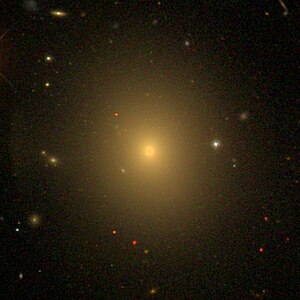NGC 7626
| Galaxy NGC 7626 |
|
|---|---|

|
|
| SDSS recording | |
| AladinLite | |
| Constellation | Pegasus |
|
Position equinox : J2000.0 , epoch : J2000.0 |
|
| Right ascension | 23 h 20 m 42.5 s |
| declination | + 08 ° 13 ′ 01.1 ″ |
| Appearance | |
| Morphological type | E / pec: / LINER |
| Brightness (visual) | 11.2 mag |
| Brightness (B-band) | 12.2 mag |
| Angular expansion | 2.6 ′ × 2.3 ′ |
| Position angle | 9 ° |
| Surface brightness | 13.2 mag / arcmin² |
| Physical data | |
| Redshift | 0.011358 +/- 0.000013 |
| Radial velocity | 3405 ± 4 km / s |
|
Stroke distance v rad / H 0 |
(159 ± 11) · 10 6 ly (48.7 ± 3.4) Mpc |
| history | |
| discovery | William Herschel |
| Discovery date | September 26, 1785 |
| Catalog names | |
| NGC 7626 • UGC 12531 • PGC 71140 • CGCG 406-76 • MCG + 01-59-57 • 2MASX J23204252 + 0813014 • GC 4940 • H II-440 • h 2233 • | |
NGC 7626 is an elliptical galaxy with an active nucleus of the Hubble type E1 in the constellation Pegasus in the northern sky . It has an angular dimension of 2.6 '× 2.3' and an apparent magnitude of 11.2 mag. The galaxy is an estimated 159 million light years away from the Milky Way and is approximately 120,000 light years across .
The galaxies NGC 7617 , NGC 7619 , NGC 7621 , NGC 7631 are located in the same area of the sky .
The object was discovered by William Herschel on September 26, 1785 .
